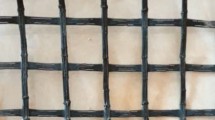Conclusions
-
1.
The proposed method of calculating reinforced-concrete slabs of slope protection for wave loads is simple and sufficiently accurate.
-
2.
With consideration of the combined work of slabs interconnected by reinforcement and absorbing the wave uplife pressure the thickness of the slabs is less than in the calculation for the one most loaded slab (36 and 45 cm), i.e., a 20–25% saving of concrete is obtained.
-
3.
For the investigated conditions the reinforcement should be placed in the lower section of the slab: in this case the amount of reinforcement per 1 m3 of concrete will be 20 kg. When it is placed in the middle of the section its amount will be 30 kg/m3 of concrete, i.e., 1.5 times more. It is also seen from the calculation that the reinforcement is principal in both directions (it is usually considered mounting reinforcement in the direction parallel to the water's edge and is placed for construction purposes, which is not true, especially for square slabs).
-
4.
In the case of alternating loads, for example, from the effect of an ice cover with consideration of a change in the water level in the reservoir, it can be advisable to place the reinforcement in the middle of the section. In this case some saving of reinforcement is obtained (as opposed to double reinforcement) and construction is simplified.
-
5.
The value of flexibility determined by Eq. (13) is considerably greater than 100, which means that it does not affect the final results of the calculations.
Similar content being viewed by others
Literature cited
SNiP II-57-75. Construction Specifications and Regulations. Pt. II, Chap. 57. Loads and Effects on Hydraulic Structues (Wave, Ice, and From Ships) [in Russian].
SNiP II-B.3-62. Construction Specifications and Regulations. Pt. II, Sec. B, Chap. 3. Foundations of Hydraulic Structures. Design Standards [in Russian].
V. P. Likhachev, S. V. Luzan, A. V. Mikhailov, et al., Methods of Calculating the Stability and Strength of Hydraulic Structures [in Russian], Stroiizdat, Moscow (1966).
SNiP II-I.14-69. Construction Specifications and Regulations. Pt. II, Sec. I, Chap. 14. Concrete and Reinforced-Concrete Constructions of Hydraulic Structures. Design Standards [in Russian].
SNiP II-56-77. Construction Specifications and Regulations, Pt. II, Chap. 56. Concrete and Reinforced-Concrete Constructions of Hydraulic Structures [in Russian], Moscow.
Handbook on the Design of Concrete and Reinforced-Concrete Constructions of Heavy Concrete (without prestressing) [in Russian], Stroiizdat, Moscow (1977).
M. I. Gorbunov-Posadov and T. Mailikova, Calculation of a Structure on an Elastic Foundation [in Russian], Stroiizdat, Moscow (1977).
G. V. Krasheninnikova, Calculation of Beams on an Elastic Foundation of Finite Depth [in Russian], Énergiya, Moscow-Leningrad (1964).
A. D. Shabanov and N. Ya. Kichigina, Calculation of Reinforced-Concrete Slabs for Dynamic Wave Loads [in Russian], Kuibyshev State Univ. (1977).
A. D. Shabanov, Calculation and Design of Reinforced-Concrete Revetment Slabs of Upstream Slopes of Earth Structures [in Russian], KuISI, Kuibyshev (1975).
Additional information
Translated from Gidrotekhnicheskoe Stroitel'stvo, No. 1, pp. 31–34, January, 1983.
Rights and permissions
About this article
Cite this article
Shabanov, A.D., Kichigina, N.Y. Approximate method of calculating reinforced-concrete slabs of slope protection for wave loads. Hydrotechnical Construction 17, 43–49 (1983). https://doi.org/10.1007/BF01427415
Issue Date:
DOI: https://doi.org/10.1007/BF01427415




